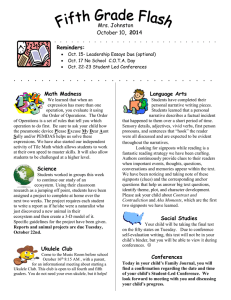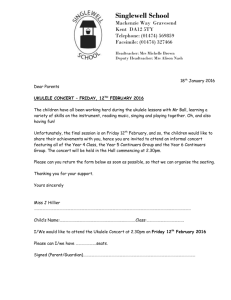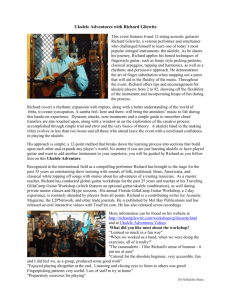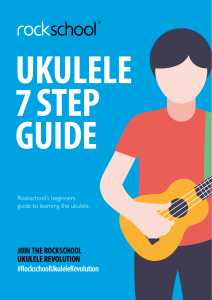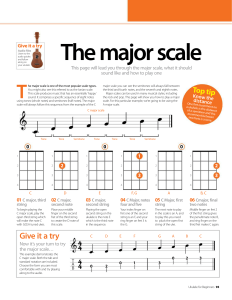Visual and Performing Arts: Performing Arts Music Unit 4: Ukulele
advertisement
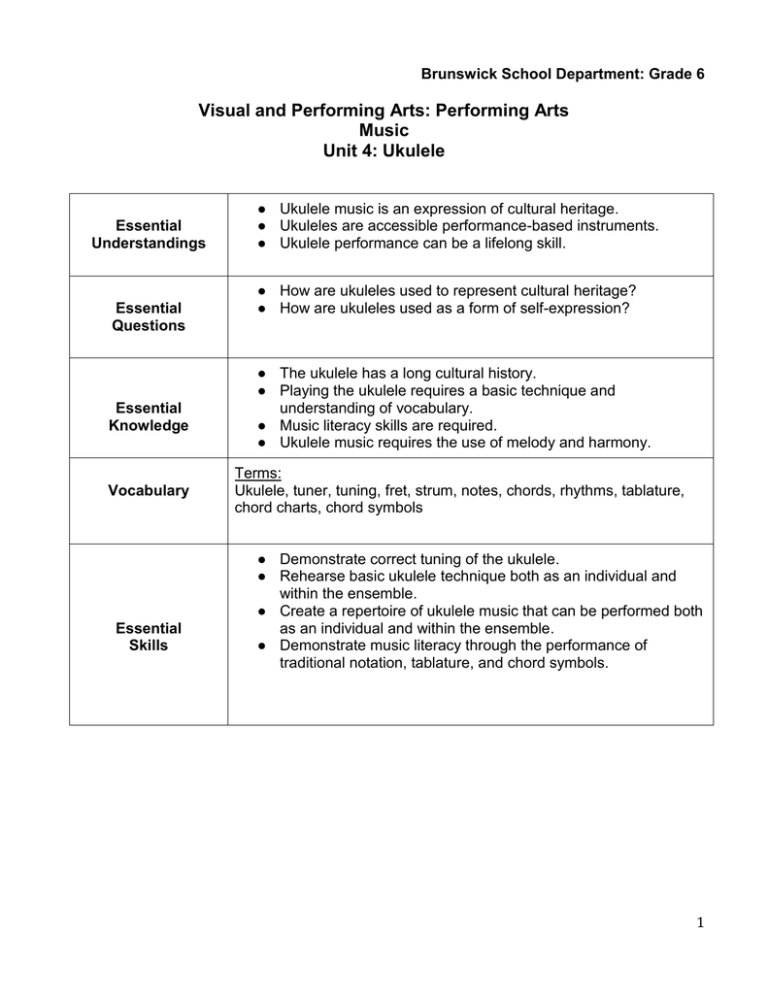
Brunswick School Department: Grade 6 Visual and Performing Arts: Performing Arts Music Unit 4: Ukulele Essential Understandings Essential Questions Essential Knowledge Vocabulary Essential Skills ● Ukulele music is an expression of cultural heritage. ● Ukuleles are accessible performance-based instruments. ● Ukulele performance can be a lifelong skill. ● How are ukuleles used to represent cultural heritage? ● How are ukuleles used as a form of self-expression? ● The ukulele has a long cultural history. ● Playing the ukulele requires a basic technique and understanding of vocabulary. ● Music literacy skills are required. ● Ukulele music requires the use of melody and harmony. ▪ Terms: o Ukulele, tuner, tuning, fret, strum, notes, chords, rhythms, tablature, chord charts, chord symbols ● Demonstrate correct tuning of the ukulele. ● Rehearse basic ukulele technique both as an individual and within the ensemble. ● Create a repertoire of ukulele music that can be performed both as an individual and within the ensemble. ● Demonstrate music literacy through the performance of traditional notation, tablature, and chord symbols. 1 Brunswick School Department: Grade 6 Visual and Performing Arts: Performing Arts Music Unit 4: Ukulele Standards: Maine Learning Results Standards And Common Core A Disciplinary Literacy: Students show literacy in the discipline by understanding and demonstrating concepts, skills, terminology, and processes A1. Music Difficulty: Students accurately perform music with moderate technical demands, modeling proper posture and technique, alone or with others. A2. Notation and Terminology: Students apply accumulated knowledge of musical notation, symbols, and terminology to a music performance. a. Read simple melodies in treble clef c. Apply notation symbols for pitch, rhythm, dynamics, tempo A3. Listening and Describing: Students listen to and compare elements of music, including pitch, rhythm, tempo, dynamics, form, timbre, texture, harmony, style B Creation, Performance, and Expression: Students create, perform, and express through the art discipline B1. Style/Genre: Students perform music of various styles that includes moderate technical demands accurately applying the accumulated knowledge and skills of proper posture and technique; musical notation, symbols, and terminology. B2. Composition: Students compare musical ideas expressed in the compositions of others. C Creative Problem Solving: Students describe and apply creativethinking skills that are part of the creative solving process. C1. Application of Creative Process a. fluency b. flexibility c. elaboration d. originality e. analysis D Aesthetics and Criticism: Students describe, analyze, interpret, and evaluate art (dance, music, theatre, and visual arts.) D1.Students compare and analyze art forms: a. by applying grade span appropriate concepts, vocabulary, skills and processes b. by using multiple criteria from observations, print and/or nonprint resources c. by comparing the effectiveness of selected media, techniques, and processes in communicating ideas d. explain and compare different purposes of artists and art work in the context of time and place. 2 Brunswick School Department: Grade 6 Visual and Performing Arts: Performing Arts Music Unit 4: Ukulele E Visual and Performing Arts Connections: Students understand the relationship among the arts, history and world culture; and they make connections among the arts and to other disciplines, to goal-setting, and to interpersonal interaction. E1. Students compare products of the visual/performing arts to understand history and/or world cultures E2. Students explain skills and concepts that are similar across disciplines E3. Students set goals related to time management, interpersonal interactions, or skill development that will lead to success in the arts E4. Students explain the impact of artistic and career choices on self, others, and the natural and man-made environment E5. Students demonstrate positive interpersonal skills and analyze how interpersonal skills affect participation in the arts a. Getting along with others b. Respecting differences c. Working as a team/ensemble d. Managing conflict e. Accepting/giving/using constructive feedback f. Accepting responsibility for personal behavior g. Demonstrating ethical behavior h. Following established rules/etiquette for observing/listening to art i. Demonstrating safe behavior 3 Brunswick School Department: Grade 6 Visual and Performing Arts: Performing Arts Music Unit 4: Ukulele Sample Lessons And Activities Sample Classroom Assessment Methods Sample Resources ● ● ● ● ● ● ● ● Teach the identification of the parts of a ukulele Teach the identification of the ukulele strings Teach the use of a tuner through demonstration Model correct holding and playing positions Model music literacy through the reading of chord charts Practice ukulele skills to achieve fluidity and technique Model chords and their use in harmonic structure Perform repertoire using melodic lines by reading traditional notation and tablature ● Watch/listen to video/audio examples of ukulele performance ● Worksheets ● Classroom observation of individual participation in a performance-based class ● Written quizzes ● Classroom observation of ensemble participation in a performance-based class ● Other Resources: ● YouTube ● “Mighty Uke” (DVD) ● Ukulele for each student ● Tuners 4

